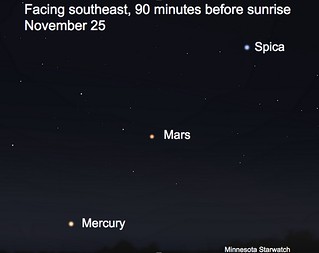Northern Sky: November 9 - 22
Northern Sky by Deane Morrison
Nov. 9-22 2019
Now that we’re back on Standard Time, nightfall comes early. The switchover sucked an hour of darkness from the morning sky, so now we have to get out really early to watch the morning stars and planets. Sure, the sun has been rising later each morning since the switchover, but we won’t get all that darkness back again until December 17. The sun will keep coming up later for the rest of December and into January, but on January 6 it starts coming up earlier.
If you’re out an hour before sunrise between November 9 and 13, you can watch Spica, the brightest star in Virgo, the maiden, climb in the eastern sky and slide past Mars. Spica and Mars are closest on the 10th. Then on the 11th and especially the 12th, the two are at virtually the same altitude, with Spica on the right. Spica and the other stars go right on moving higher and westward, but Mars’ orbital motion eastward keeps it from pulling away from the rising sun as fast as the stars do. So Mars will be low and dim for a while, but in less than a year it’ll be the star of the evening show.
Over in the west, the sky is waiting for the next “evening star” to climb into prominence. That would be Venus. Venus is slowly pulling itself out of the setting sun’s afterglow. Meanwhile, Jupiter and Saturn are sinking toward it as Earth leaves them behind in the orbital race. By the 22nd, Venus and Jupiter will have drawn close together, very low in the southwest, with Venus, the brighter planet, below Jupiter, getting ready to pass it. As they approach each other and pass, the trick is to catch the planets when it’s gotten dark enough to see them but before they drop too close to the horizon. When Venus and Saturn pass next month, it’ll happen a little higher in the sky.
At nightfall on November 10th, the waxing moon will be above the eastern horizon. At about the same altitude, off to the left, is the bright star Capella, in the constellation Auriga the charioteer. Later in the evening, when the bright winter constellations are all up in the east, Capella will be at the top of the heap. As for the moon, to see it closest to full, look westward on the morning of the 12th, at least a half hour before it sets at 6:51 a.m.
On Monday the 11th, the sun rises with a tiny round, black dot on its face. That's Mercury, making a rare transit, which occurs when Mercury passes between Earth and the sun and we see Mercury crossing the face of the sun. Mercury passes between us and the sun three or four times a year, but because the plane of its orbit is tilted seven degrees from Earth’s, its orbit usually carries it above or below the sun from our point of view. If our two planets orbited in the same plane, we’d see transits during every passage of Mercury between Earth and the sun. For us to see a transit during a passage, Earth must, at that moment, be at or very near one of the two points where its orbit intersects the plane of Mercury’s orbit. That puts both Mercury and the sun in our line of sight, and so the planet appears to crawl across the sun’s face. From Minnesota, the transit will be under way at sunrise, but it lasts until 12:04 p.m. Don’t watch it without proper eye protection, especially when some websites will stream it live. Just search online for “live webcast Mercury transit 2019.”
Tweet




